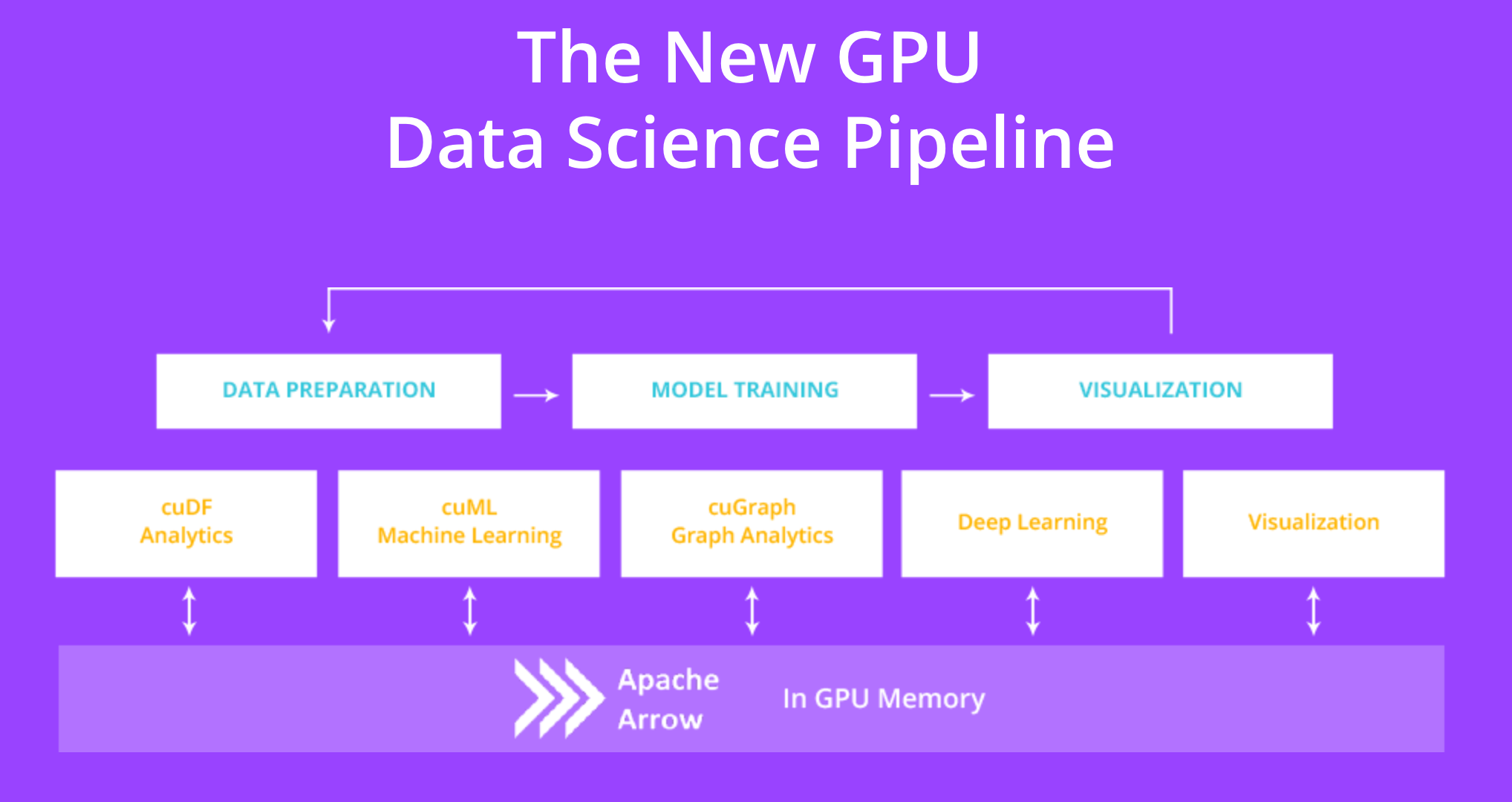cuML is a suite of libraries that implement machine learning algorithms and mathematical primitives functions that share compatible APIs with other RAPIDS projects.
cuML enables data scientists, researchers, and software engineers to run traditional tabular ML tasks on GPUs without going into the details of CUDA programming. In most cases, cuML's Python API matches the API from scikit-learn.
For large datasets, these GPU-based implementations can complete 10-50x faster than their CPU equivalents. For details on performance, see the cuML Benchmarks Notebook.
As an example, the following Python snippet loads input and computes DBSCAN clusters, all on GPU:
import cudf
from cuml.cluster import DBSCAN
# Create and populate a GPU DataFrame
gdf_float = cudf.DataFrame()
gdf_float['0'] = [1.0, 2.0, 5.0]
gdf_float['1'] = [4.0, 2.0, 1.0]
gdf_float['2'] = [4.0, 2.0, 1.0]
# Setup and fit clusters
dbscan_float = DBSCAN(eps=1.0, min_samples=1)
dbscan_float.fit(gdf_float)
print(dbscan_float.labels_)Output:
0 0
1 1
2 2
dtype: int32
cuML also features multi-GPU and multi-node-multi-GPU operation, using Dask, for a growing list of algorithms. The following Python snippet reads input from a CSV file and performs a NearestNeighbors query across a cluster of Dask workers, using multiple GPUs on a single node:
# Create a Dask CUDA cluster w/ one worker per device
from dask_cuda import LocalCUDACluster
cluster = LocalCUDACluster()
# Read CSV file in parallel across workers
import dask_cudf
df = dask_cudf.read_csv("/path/to/csv")
# Fit a NearestNeighbors model and query it
from cuml.dask.neighbors import NearestNeighbors
nn = NearestNeighbors(n_neighbors = 10)
nn.fit(df)
neighbors = nn.kneighbors(df)For additional examples, browse our complete API documentation, or check out our introductory walkthrough notebooks. Finally, you can find complete end-to-end examples in the notebooks-contrib repo.
| Category | Algorithm | Notes |
|---|---|---|
| Clustering | Density-Based Spatial Clustering of Applications with Noise (DBSCAN) | |
| K-Means | Multi-node multi-GPU via Dask | |
| Dimensionality Reduction | Principal Components Analysis (PCA) | Multi-node multi-GPU via Dask |
| Truncated Singular Value Decomposition (tSVD) | Multi-node multi-GPU via Dask | |
| Uniform Manifold Approximation and Projection (UMAP) | ||
| Random Projection | ||
| t-Distributed Stochastic Neighbor Embedding (TSNE) | ||
| Linear Models for Regression or Classification | Linear Regression (OLS) | |
| Linear Regression with Lasso or Ridge Regularization | ||
| ElasticNet Regression | ||
| Logistic Regression | ||
| Stochastic Gradient Descent (SGD), Coordinate Descent (CD), and Quasi-Newton (QN) (including L-BFGS and OWL-QN) solvers for linear models | ||
| Nonlinear Models for Regression or Classification | Random Forest (RF) Classification | Experimental multi-node multi-GPU via Dask |
| Random Forest (RF) Regression | Experimental multi-node multi-GPU via Dask | |
| Inference for decision tree-based models | Forest Inference Library (FIL) | |
| K-Nearest Neighbors (KNN) | Multi-node multi-GPU via Dask, uses Faiss for Nearest Neighbors Query. | |
| K-Nearest Neighbors (KNN) Classification | ||
| K-Nearest Neighbors (KNN) Regression | ||
| Support Vector Machine Classifier (SVC) | ||
| Epsilon-Support Vector Regression (SVR) | ||
| Time Series | Linear Kalman Filter | |
| Holt-Winters Exponential Smoothing | ||
| Auto-regressive Integrated Moving Average (ARIMA) | Supports seasonality (SARIMA) |
See the RAPIDS Release Selector for the command line to install either nightly or official release cuML packages via Conda or Docker.
See the build guide.
Please see our guide for contributing to cuML.
Find out more details on the RAPIDS site
The RAPIDS suite of open source software libraries aim to enable execution of end-to-end data science and analytics pipelines entirely on GPUs. It relies on NVIDIA® CUDA® primitives for low-level compute optimization, but exposing that GPU parallelism and high-bandwidth memory speed through user-friendly Python interfaces.

